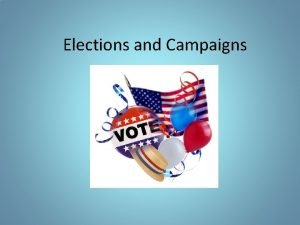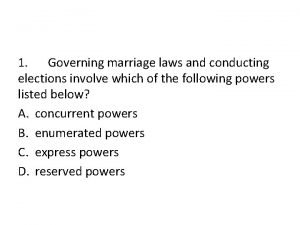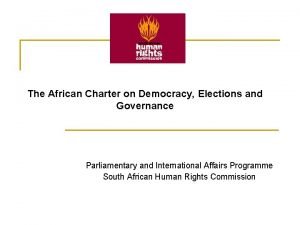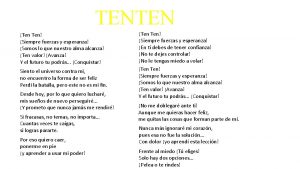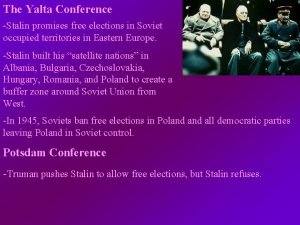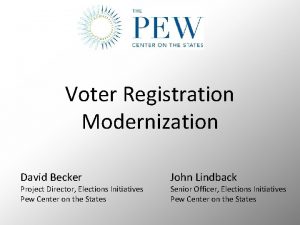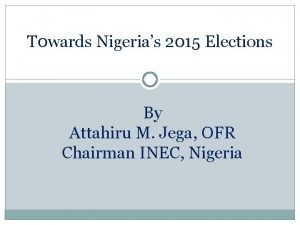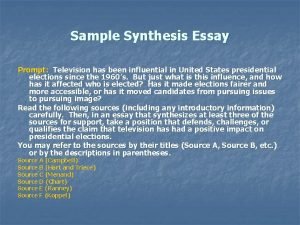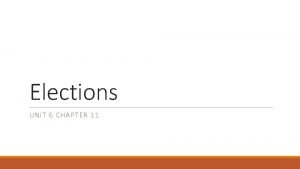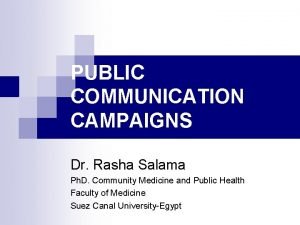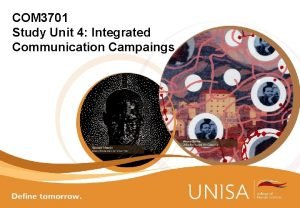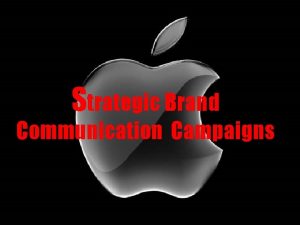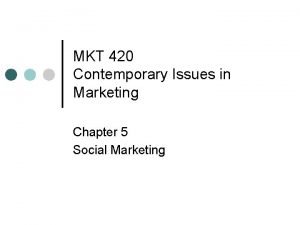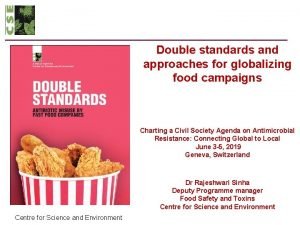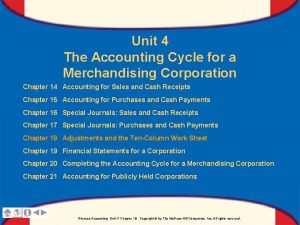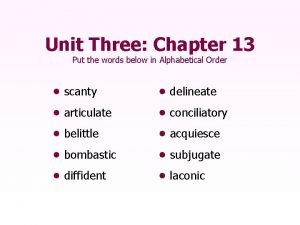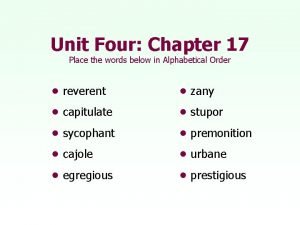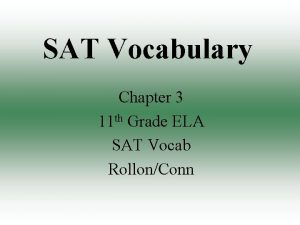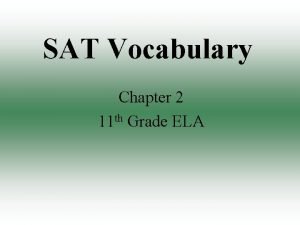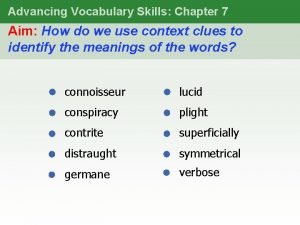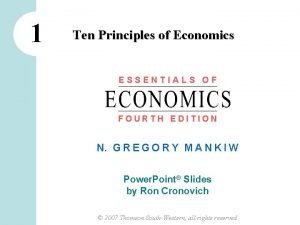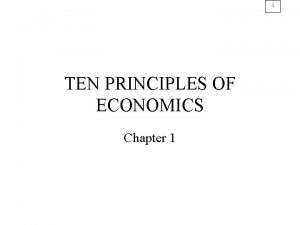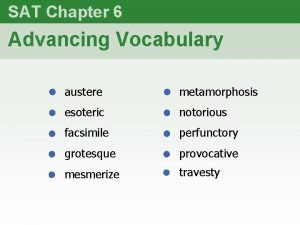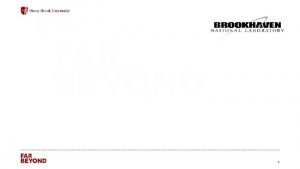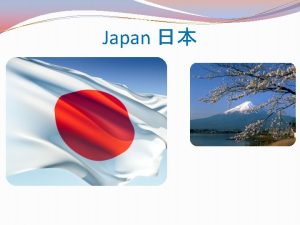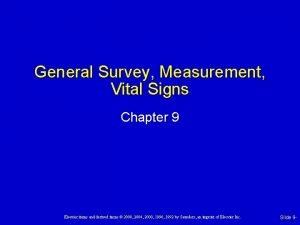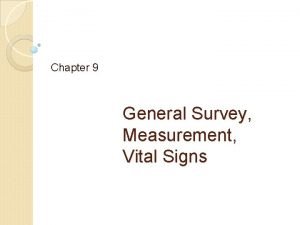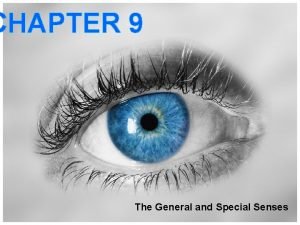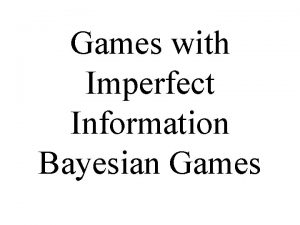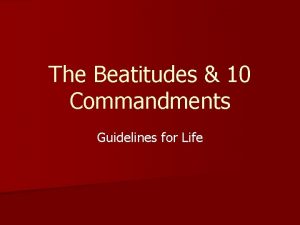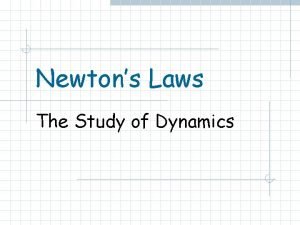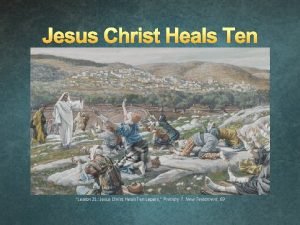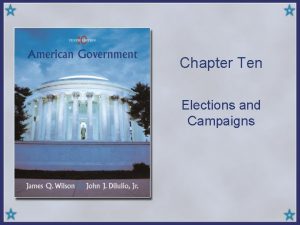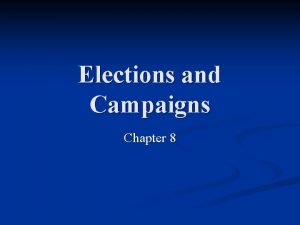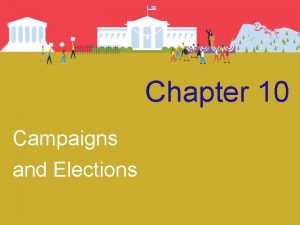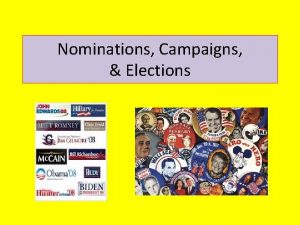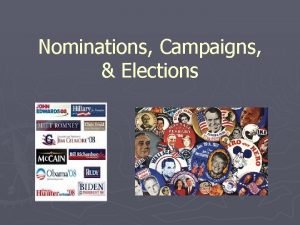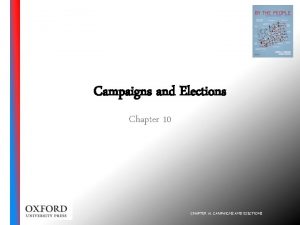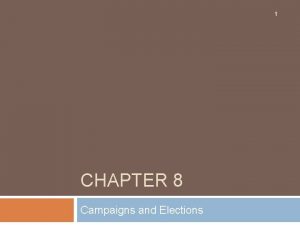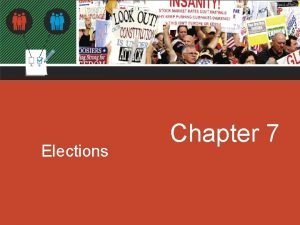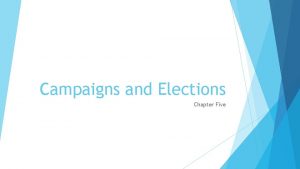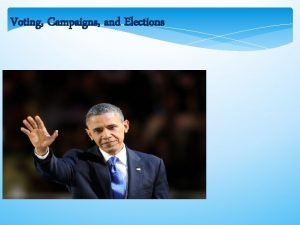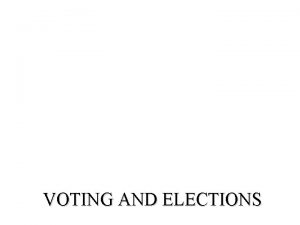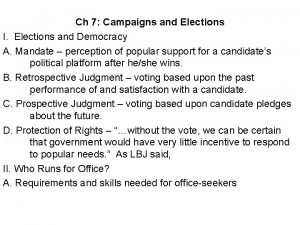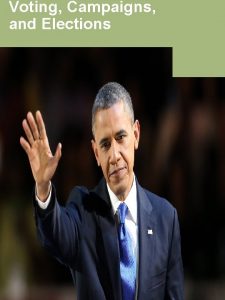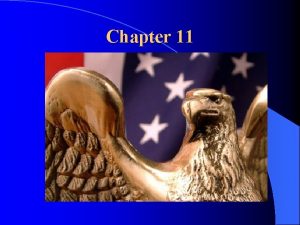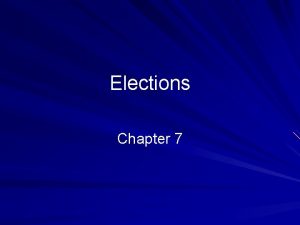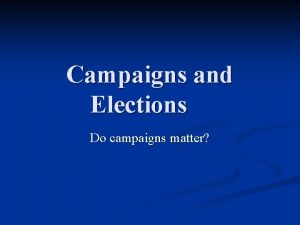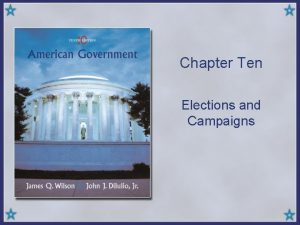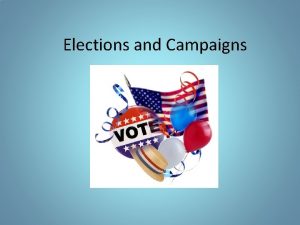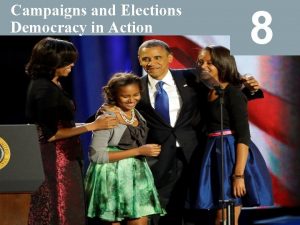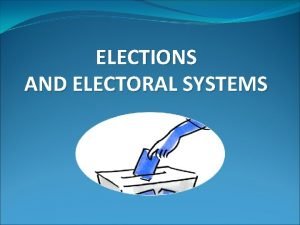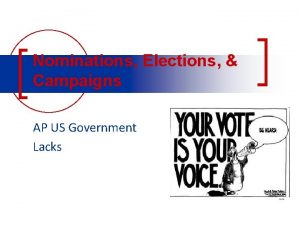Chapter Ten Elections and Campaigns Campaigns General Information




















































- Slides: 52

Chapter Ten Elections and Campaigns

Campaigns • General Information • Consist of: (TASKS) Talking to voters Passing out campaign flyers Putting up yard signs Getting attention of local media – Calling people on the phone – – • National & State Campaigns • Two phases 1. Campaign before the party nomination 2. Effort between the time of nomination and the general election • Different rules apply to each phase – Financing rules 10 | 2

Presidential v. Congressional Campaigns • There is more voter participation in presidential campaigns • Presidential races are more competitive than House races 10 | 3

Presidential v. Congressional Campaigns • Lower turnout in off years means that candidates must appeal to more motivated and partisan voters • Members of Congress can do things for their constituents that the president cannot • Members of Congress can distance themselves from the “mess in Washington” 10 | 4

Presidential Campaign • Step One • Decision to Run – Must have the money and support • These issues need to be seriously evaluated – Are they ready for the psychological and personal toll? • Make it public through an announcement – Next step: gaining the most support at the primaries – Strategy must be planned to gain the most support • Step Two • Winning Delegates (1, 144) – Primaries and Caucuses • Begin in February before the November of the general election • End in June of the same year – All states must complete their primaries and caucuses before the national convention delegates meet – Winning the initial primary is HUGE (New Hampshire) • Creates a big media buzz about the candidate 10 | 5

Presidential Campaign • Step 3 • The Convention – Held in July or August before the November of the general election • Present conventions serve as a pep rally – Each party has known who its candidate has been – Used as a media tool • Step 4 • General Election Stage – Constant campaigning until the day of the general election in November • During this stage: – Concentrate on the American public, not a political party – Hiring starts: • Campaign mangers • Media consultants • Speech writers – All to try to gain the advantage – Television debates • Very common and expected now – Debate the hot topics and educate the public 10 | 6

Convention 10 | 7

Congressional Campaigns • Positions up for battle? • Differences from Presidential Campaign • Representatives 1. Announcement of who is • Senators running is not made so far in advance 2. Races are smaller than presidential races 3. Less expensive to run 4. Less competitive 10 | 8

Congressional Elections • Incumbents have an extraordinary advantage – and no terms limits in Congress • Each state has two senators; number of House representatives based on state population, as determined by the census • House members are now elected from single-member districts 10 | 9

Campaign Financing • Funds needed? – Millions …. • Presidential campaigning requires an enormous amount of money – 1996 presidential campaign: » Clinton and Dole campaigns spent about $232 million » $69 million in “issue ads” paid for by the Republican and Democratic National Committees – 1996 Presidential + State + Local elections financing = 4. 1 billion 10 | 10

Source of Funds • Private Sources • Private individuals contribute to the campaigns they support – This was looked at as an unfair advantage – some people would give huge sums of money • There is a limit set by the FEC for how much an individual can give – Much funding come from average people donating $100 to $200 • Political Action Committees • PAC – Created by any group that wants to influence government • Groups like: – Corporations – Labor Unions – Professional Organizations – Pool voluntary contributions of their members into a single fund • Give that money to their favored candidate 10 | 11

Source of Funds • Public Sources • Government funding – Helps with Presidential funding • If you accept the funding, the candidate can not spend more than what is given to them • Government matches funds of all money no more than $250 – Congressional Candidates • Receive no government funding • They rely on PAC money 10 | 12

Funding for Congressional Elections • Most money comes from individual small donors ($100–$200 a person) • $2, 000 maximum for individual donors • $5, 000 limit for PACs, but most give just a few hundred dollars • Challengers must supply much of their own money 10 | 13

Campaign Financing • Where does the money go? • Majority goes to television and radio ads – Ex. ) Bill Clinton spent $44 million on these ads • Helped him win the presidency • Congressional campaigns – Spend less on these types of ads • Federal Election Committee • FEC – Oversees campaign funding • Sets limits on contributions and expenditures – Two major issues: 1. Control of overall cost 2. Limits on individual limitation • If any incumbent has a lot of money, this can scare away challengers – Can’t compete with the lack of exposure 10 | 14

Figure 10. 1: The Cost of Winning Updated from Federal Election Commission report, May 15, 2001. Copyright © Houghton Mifflin Company. All rights reserved. 10 | 15

Figure 10. 2: Growth of PACs Federal Election Commission. Copyright © Houghton Mifflin Company. All rights reserved. 10 | 16

Table 10. 2: Sources of Campaign Funds: All House and Senate Candidates in 2001 -2002, by Party (in Millions) 10 | 17

Loopholes and Concerns • 1. Soft Money • Money not regulated by federal law – Used by political parties for general expense – Party-building activities • Issue ads • Increase voting drives • Voter registration campaigns • 2. Fund-Raising Tactics • People using their power and perks – Bill Clinton was accused of allowing people to spend the night in Lincoln’s bedroom in the White House in return for money – Is this ethical? • No limit on soft money accounts – Parties are getting very creative with this account and what they spend it on 10 | 18

Loopholes and Concerns • 3. The High Cost of Campaigns • Do you think spending over 2. 7 billion on campaigns is necessary? – Should we have regulations that keep it fair? – If not, will the person with the most money always win? 10 | 19

Drawing District Boundaries • Malapportionment: districts have very different populations, so the votes in the less-populated district “weigh more” than those in the more-populated district • Gerrymandering: boundaries are drawn to favor one party rather than another, resulting in odd-shaped districts 10 | 20

Staying in Congress • Members gear their offices to help individual constituents • Committee members secure pork for the district • Members must decide to what extent to be delegates ( to do what the district wants) versus trustees ( to use their independent judgment) 10 | 21

1974 Campaign Finance Reform • 1972: Watergate and illegal donations from corporation, unions, and individuals catalyzed change • Brought about the 1974 federal campaign reform law and Federal Election Commission (FEC) 10 | 22

Raising Money • Individuals can give $2, 000; PACs can give $5, 000 in each election to each candidate • Candidates must raise $5, 000 in twenty states in individual contributions of $250 or less to qualify for federal matching grants to pay for primary campaigns 10 | 23

Problems with Campaign Financing • Independent expenditures: an organization or PAC can spend as much as it wishes on advertising, so long as it is not coordinated with a candidate’s campaign • Soft money: unlimited amounts of money may be given to a political party, so long as a candidate is not named 10 | 24

Bipartisan Campaign Finance Reform Act • Banned soft money contributions to national parties from corporations and unions after the 2002 election • Raised the limit on individual donations to $2, 000 per candidate per election 10 | 25

Bipartisan Campaign Finance Reform Act • Sharply restricted independent expenditures – Corporations, unions, trade associations, nonprofit organizations cannot use their own money for an advertisement referring to a candidate by name 30 days before a primary and 60 days before a general election 10 | 26

527 Organizations • A new source of money under the Bipartisan Campaign Reform Act • Designed to permit the kind of soft money expenditures once made by political parties • They can spend their money on politics so long as they do not coordinate with a candidate or lobby directly for that person 10 | 27

Money and Winning • Presidential candidates have similar funds because of federal funding • During peacetime, presidential elections are usually decided on the basis of three factors: – Political party affiliation – The economy – Character 10 | 28

Figure 10. 3: The Economy and Vote for President, 1948 -2004 Updated from Robert S. Erikson and Kent L. Tedin, American Public Opinion, 5 th ed. , p. 271. Copyright © 1995 by Allyn & Bacon/Longman. Reprinted by permission of Pearson Education, Inc. 10 | 29

Voter Behavior • V. O. Key: most voters who switch parties do so in their own interests • Prospective voting is used by relatively few voters • Retrospective voting is practiced by most voters, and decides most elections 10 | 30

Coalitions • Democratic coalition: African Americans, Jews, Hispanics (not Cuban) • Catholics, southerners and union members are leaving the Democrats • Republican coalition: business and professional people who are very loyal, farmers 10 | 31

Figure 10. 4: Partisan Division of Presidential Vote, 1856 -2004 Updated from Historical Data Archive, Inter-University Consortium for Political Research, as reported in William H. Flanigan and Nancy H. Zingale, Political Behavior of the American Electorate, 3 rd ed. , 32. 10 | 32

Do Elections Make a Difference in Policy? • Many American elections do make differences in policy • But the constitutional system generally moderates the pace of change 10 | 33

Information about Elections

Laws and The Electoral Process • Scheduling Elections – Elections are always held at a scheduled time • These times are usually set by our state and national rules • Elections always held at a specific time – Even if at war or national crisis • All elected officials are serving on fixed terms – A set amount of years » Representatives: 2 years » Senators: 6 years » President: 4 years

Laws and The Electoral Process • Polling Places and Ballots – Precincts responsibilities: • Count the votes casted – Voting place • Local precincts – Libraries, firehouses, schools – Voting • Secret ballots: person's • vote is kept secret, but the amassed votes of various groups are revealed publicly Absentee ballots: vote cast by someone who is unable or unwilling to attend the official polling station

Elections • Nomination Process – Primaries • Direct primaries held in the spring before the general elections in the fall – Direct primaries: Choosing the party’s main candidate for the general election – General elections: select the winners of the government positions • All primaries fall under state rule, so the rules could be different for each state

Types of Elections • Primaries – Type of Primaries • Closed Primaries – Only registered party members can vote » Most states use this type of primary – Restricts switching party affiliation • Open Primary – Any qualified voter can participate » Only in a few states use this primary – This allows voters to switch party affiliation

Types of Elections • Nomination Process – Caucuses • Meeting of leaders of a political party to select candidates » Most commonly used in state and local governments, but used infrequently • At these local meetings, party leaders meet to decide – Party support – Strategy – Conduct party business

Differences Primaries Caucus • Same as General Election • Voters stay for duration – Turn in your vote and leave • Secret ballot in polling • Cast vote and leave • Higher turn out – Less time commitment – Can be 15 minutes or 7 hours, etc… • Face to face votes – Show of hands • Discussion and debate – Try to gain votes, and may loss votes • Elimination of Candidates – Based on state rules • Ex. ) Iowa: if you receive less than 15% of the vote, your eliminated

Types of Elections • General Election – Voting for Congress • By law, must be selected on the Tuesday after the first Monday in November – Voting for President and Vice President • Voted every other year of the Congressional election – State and local elections • May occur in odd-numbered years and not necessarily in November – Have to follow the Primaries, so voting occurs late spring, summer, and fall

Type of Elections • Mid Term Elections – Mid-term elections occur in the middle of a president's term in office • Hence the name mid-term – Mid-term elections usually involve • State governors • State and federal congressmen • Local elected positions: – County commissioners – City councilmen – Judges – Since US senators serve 6 year terms: • Their re-election campaigns are usually held during mid-term elections

Districts – Electoral Votes

Districts 2000 Michigan Districts 2010 Michigan Districts

Michigan Representatives There are 110 Michigan Representatives who are elected by the qualified electors of Districts having approximately 77, 000 to 91, 000 residents Legislative districts are drawn on the basis of population figures through the federal decennial census Representatives are elected in evennumbered years to 2 -year terms Representative is limited to serving 3 terms

Michigan Senators The Senate consists of 38 members Districts having approximately 212, 400 to 263, 500 residents Senators are elected at the same time as the governor and serve 4 year terms concurrent with the governor's term of office

District Change • Census (population count) – Constitution provides that a census be given every 10 years • Each district is considered a apportionment – The amount of people each representative represents based on population • Census causes reapportionment – Periodic redistribution of people of U. S. congressional seats according to changes in the census figures – Causes for re-districting

Districts 2000 Michigan Districts 2010 Michigan Districts

Districts • Gerrymandering • The process of dividing voting districts to give an unfair advantage to one candidate, party, or group – Given the name back in 1812 – Governor Gerry Elbridge • District lines where drawn to favor a prominent political party • Painter drew wings, heads and claws on his district – Resembled a salamander

Districts Gerrymandering Governor Gerry created a district that would ensure the election Supreme Court ruled: each district must represent approximately the same number of people as all others

Electoral Votes The number of Representative + (2) senators = States Electoral Vote

Electoral Votes Amount of electoral votes needed to become President: 270 Electoral College selects our President of the United States
 Presidential elections exploration and announcement
Presidential elections exploration and announcement Governing marriage laws and conducting elections
Governing marriage laws and conducting elections African charter on democracy, elections and governance
African charter on democracy, elections and governance Ten twenty thirty
Ten twenty thirty Ten ten siempre fuerzas y esperanza
Ten ten siempre fuerzas y esperanza Am i a 10/10
Am i a 10/10 Stalin promise free elections
Stalin promise free elections David becker elections
David becker elections Conclusion on elections
Conclusion on elections Ap lang synthesis essay television presidential elections
Ap lang synthesis essay television presidential elections “elections are key to democracy”
“elections are key to democracy” Public communication definition
Public communication definition Interactive model of communication campaigns four phases
Interactive model of communication campaigns four phases International marketing campaigns
International marketing campaigns Informed delivery campaigns
Informed delivery campaigns Informed delivery campaign
Informed delivery campaign Strategic brand communication campaigns
Strategic brand communication campaigns Contemporary issues in marketing
Contemporary issues in marketing Fast food campaigns
Fast food campaigns Journalizing adjusting entries
Journalizing adjusting entries Planos en cinematografia
Planos en cinematografia Where did general lee surrender to general grant?
Where did general lee surrender to general grant? Put the words below in alphabetical order
Put the words below in alphabetical order One of the four chapter 17
One of the four chapter 17 10 essentials of a successful ffa chapter
10 essentials of a successful ffa chapter Chapter 16 ten words in context
Chapter 16 ten words in context Chapter 13 ten words in context sentence check 2 answers
Chapter 13 ten words in context sentence check 2 answers Chapter 25 ten words in context
Chapter 25 ten words in context Chapter 23 sentence check 1
Chapter 23 sentence check 1 Chapter 12 sentence check 1
Chapter 12 sentence check 1 Chapter 10 ten words in context answer key acute
Chapter 10 ten words in context answer key acute Ten words in context chapter 3
Ten words in context chapter 3 Ten words in context chapter 2
Ten words in context chapter 2 One of the ten principles of economics in chapter 1
One of the ten principles of economics in chapter 1 Ten word parts in context chapter 6
Ten word parts in context chapter 6 Ten words in context chapter 7
Ten words in context chapter 7 One of the ten principles of economics in chapter 1
One of the ten principles of economics in chapter 1 Ten principles of economics chapter 1
Ten principles of economics chapter 1 Chapter 6 ten words in context
Chapter 6 ten words in context What are the ten essentials of a successful ffa chapter
What are the ten essentials of a successful ffa chapter General information about japan
General information about japan Scotland general information
Scotland general information Provides general information
Provides general information Body structure general survey
Body structure general survey Normal pediatric vitals by age
Normal pediatric vitals by age The general and special senses chapter 9
The general and special senses chapter 9 Chapter 6 general anatomy and physiology
Chapter 6 general anatomy and physiology Incomplete vs imperfect information
Incomplete vs imperfect information How to write 50 centavos
How to write 50 centavos What are the beatitudes
What are the beatitudes What is decimal notation
What is decimal notation Normal force equation
Normal force equation 10 lepers lds
10 lepers lds
